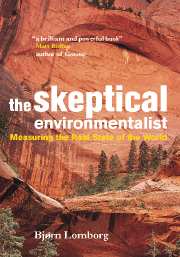Book contents
- Frontmatter
- Contents
- List of figures
- List of tables
- Preface
- Language and measures
- Acknowledgements
- Permissions
- Part I The Litany
- Part II Human welfare
- Part III Can human prosperity continue?
- 8 Are we living on borrowed time?
- 9 Will we have enough food?
- 10 Forests – are we losing them?
- 11 Energy
- 12 Non-energy resources
- 13 Water
- 14 Conclusion to Part III: continued prosperity
- Part IV Pollution: does it undercut human prosperity?
- Part V Tomorrow's problems
- Part VI The Real State of the World
- Notes
- Bibliography
- Index
14 - Conclusion to Part III: continued prosperity
Published online by Cambridge University Press: 05 March 2013
- Frontmatter
- Contents
- List of figures
- List of tables
- Preface
- Language and measures
- Acknowledgements
- Permissions
- Part I The Litany
- Part II Human welfare
- Part III Can human prosperity continue?
- 8 Are we living on borrowed time?
- 9 Will we have enough food?
- 10 Forests – are we losing them?
- 11 Energy
- 12 Non-energy resources
- 13 Water
- 14 Conclusion to Part III: continued prosperity
- Part IV Pollution: does it undercut human prosperity?
- Part V Tomorrow's problems
- Part VI The Real State of the World
- Notes
- Bibliography
- Index
Summary
We are not overexploiting our renewable resources. Worldwatch Institute tells us that food scarcity is likely to be the first indication of environmental breakdown. However, as we have seen in chapter 9, food will in all likelihood continue to get cheaper and more available, while we will be able to feed still more and more people.
The forests have not been eradicated, and since World War II the global forest coverage has been almost constant. Although rainforests are still being cut at 0.5 percent a year and some countries have chosen to use their forest resources unwisely and shortsightedly, about 80 percent of the original rainforest is still intact.
Water is a plentiful and renewable resource, though it can be scarce, partly because it has not sooner been treated as a limited and valuable resource. In many places this has given rise to very wasteful water practices. Basically, the problem is a question of better management, where water pricing can secure a reasonable and entirely sufficient amount of water for all purposes.
Perhaps more surprising, there do not seem to be any serious problems with the nonrenewable resources, such as energy and raw materials. In general, we have found so much more of these resources that, despite large increases in consumption, the years of supply still remaining have been increasing and not decreasing, for both energy and raw materials.
- Type
- Chapter
- Information
- The Skeptical EnvironmentalistMeasuring the Real State of the World, pp. 159 - 160Publisher: Cambridge University PressPrint publication year: 2001



